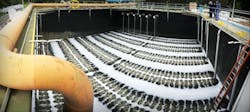Oklahoma Overhaul
Since it was first established 60 years ago, the Midwest City, Okla., Water Resources Recovery Facility (WRRF) has regularly adopted new technology to improve its process. What started as a trickling filter in 1956 became a series of rotating biological contactors (RBC), which were installed in phases from 1986 to 1990.
William Janacek, director of environmental services for Midwest City WRRF, said the plant chlorinated its effluent initially, but switched to ultraviolet (UV) disinfection for safety and space.
The most recent upgrades, however, touched on every single part of the treatment process, and the plant held a grand opening in May to showcase just how much had been changed.
Even after a major overhaul, the Midwest City WRRF still sees more opportunities to improve efficiency.
Replacing Aging Components
No stone was left unturned in replacing dated equipment.
“Every phase of the treatment train was touched to some degree,” Janacek said. “We were holding it together with baling wire and Elmer’s glue. It took me probably four years to convince the council of that.”
Metal in portions of the plant had corroded, and I-beams in some areas had weakened. Certain buildings were in such disrepair that complete replacement was the primary option for improvement.
“Everything was affected. The primary lift station where the three outfall lines from town came in was totally redone because what we had … was a constant hassle,” Janacek said. “Probably one of the most celebrated days that we had on this project was when they imploded that lift station and turned the new one on.”
Two newer grit removal systems replaced out-dated ones, which Janacek said alleviated shortcomings with the old equipment. The systems also took up less real estate, freeing up space for dry storage.
Additionally, the facility’s three primary clarifiers were overhauled in stages, so as to maintain uninterrupted service and disturb the treatment process as little as possible.
“We’ve still got sewage coming in. We’ve still got sewage going out,” Janacek said, adding he was amazed at the work put in to ensure steady service. He and project engineers also had to convince state officials that moving bed biofilm reactors (MBBR) would suffice for treatment while meeting standards.
Following what Janacek called a “natural progression,” MBBRs replaced the RBC equipment. Janacek said the shift was a major project and the RBC equipment no longer in use was paved for use as a parking lot.
Two final clarifiers were overhauled, dechlorination was phased out and the inground 600,000-gal digester system was gutted. As with other sections of the plant, antiquated digester equipment was replaced with newer technology. Midwest City also received one of the first land application permits in Oklahoma, which it used to implement a sludge thickener.
All the new equipment ties into a SCADA system with fiber optic redundancies, and operators have access to the data on mobile devices to monitor the system remotely.
Efficient Operations
Fine screen water compactors remove all solids down to 5 µ at the beginning of the treatment process. But it is with the digesters and later processes that efficiency gains are most noticeable.
“We were going into the digester on a good day with 2% solids, so we were wasting a lot of money running through the boiler and heating up a bunch of water,” Janacek said of the old equipment. “[Now we’re at] 8% to 9%, and then from the digesters where it is fully digested, it is pumped back up to the control building where our four new rotary presses are, and we end up with 18% to 22% dry solids.”
The solids are then transported into open-top trailers via conveyor belt, and are combined with dry amendment or wood chips at the Midwest City compost facility.
Additionally, Chris Thomas, chief operator for Midwest City WRRF, said the grit removal systems pull out 5 to 12 cu yd of grit per week, and average flow through the system is 5.5 to 6 million gpd.
“We have a detention time in the primary clarifiers of approximately two hours and the same in our secondary clarifiers, as well,” Thomas said, noting UV tubes are used for disinfection. The switch away from chlorine rid the facility of its 1-ton housing for the chemical while also reducing risk for workers.
Moving to MBBR equipment made the most sense for the plant’s future, Janacek said, adding training was not a large hurdle in the implementation of the equipment.
“I’ve never been a big proponent of activated sludge,” Janacek said. “The learning curve for my operators was negligible, whereas the activated sludge would have been a pretty steep learning curve.”
Striving for Further Improvements
Janacek sees a future to make the facility even more efficient. The methane produced through the treatment process, he said, is harnessed and used to fuel portions of the process. He sees room for improvement in methane usage.
“The digesters are working—I’d say—50% better than they ever have as far as methane production and the only thing we use the methane for is heating the boilers,” Janacek said. “I see the next challenge … to be harnessing methane to the tune of some microcarbons to try to make it self-sufficient out there. I think that’s imperative and I think that’s a goal that can be reached.”
Utilizing the gas produced by the plant, he said, would provide energy savings because it is exclusively fueled with electricity. A self-sufficient process also would show financial prudence considering the upgrades at the facility were paid with a local tax increase.
“We’re putting out a great effluent. We’re putting out a great compost,” Janacek said, adding that citizens have taken interest and ownership in the advancements. They have taken tours of the plant and are comforted by the design. “They’re just blown away because nobody ever pays any attention to it. Out of sight, out of mind. You flush the commode, [and] it goes away. No problem.”

